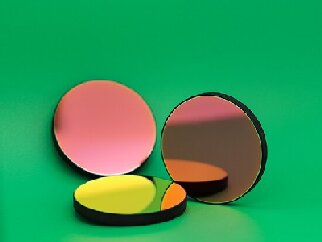Oct. 20, 2025
In numerous optical application fields, the matching use of optical filters and sensors plays a crucial role.
Basic Principles and Types of Optical Filters
An optical filter’s core function is to selectively transmit or block light within specific wavelength ranges. Based on its working principles and functional characteristics, it can be mainly classified into the following types:
Absorptive filters achieve light filtering through the light absorption properties of their materials at different wavelengths. For example, some filters containing specific dyes or pigments can absorb unwanted wavelengths and only allow the passage of light wavelengths corresponding to specific colors. A common red absorptive filter, for instance, absorbs most wavelengths except those in the red light band. These are referred to as color filters (color glass), where the glass itself performs the absorption. Their key feature is low cost.
Interference filters utilize the phenomenon of light interference for filtering. Through the interaction of reflection and transmission in multiple thin film layers, light of specific wavelengths meets the conditions for constructive interference and is transmitted, while light of other wavelengths undergoes destructive interference and is reflected or absorbed. Interference filters can achieve extremely narrow bandwidth filtering, making them highly suitable for application scenarios requiring high-precision separation of specific light wavelengths—such as separating characteristic spectral lines of specific elements in spectral analysis.
Neutral density filters are characterized by attenuating light of all wavelengths to a certain extent, with nearly uniform attenuation across the spectrum, without altering the color properties of light. They are primarily used to adjust light intensity. In situations where excessive light intensity may cause sensor saturation, the use of neutral density filters can effectively reduce light intensity and ensure the normal operation of sensors.
As a key component that receives optical signals and converts them into measurable signals, sensors also come in a variety of types, each with unique working principles and performance characteristics.
These sensors operate based on the photoelectric effect. When light irradiates their photosensitive materials, photogenerated carriers are produced, which in turn form current or voltage signals. Examples include photodiodes and phototransistors. They boast fast light response speeds, and their sensitivity can be adjusted through material and structural design, making them widely used in numerous fields such as optical communication and ambient light detection.
Common examples like CCD (Charge-Coupled Device) and CMOS (Complementary Metal-Oxide-Semiconductor) image sensors can convert optical images into digital signals to achieve imaging functions. CCD sensors offer advantages of high sensitivity and low noise, delivering high imaging quality. In contrast, CMOS sensors feature high integration, low power consumption, and low cost, and are extensively used in devices such as digital cameras and surveillance cameras.
Fiber optic sensors utilize the optical properties of optical fibers—for instance, the principle that the transmission, scattering, reflection, and other behaviors of light in optical fibers change with external environmental variations—to measure physical quantities such as temperature, pressure, and strain. Additionally, they can transmit optical signals through optical fibers, excelling in scenarios that require long-distance optical signal transmission or operation in complex electromagnetic environments.
The reasonable matching of optical filters with sensors offers numerous benefits.
Sensors are often susceptible to interference factors such as stray light in the environment. The mixing of light with different wavelengths entering the sensor may lead to deviations in measurement results. For example, during the fluorescence detection of a specific chemical substance, using an optical filter to block excitation light and other background stray light—allowing only the specific fluorescence wavelengths emitted by the substance to enter the sensor—can greatly improve the accuracy of detection signals and make the results more reliable.
Some sensors have a limited response range to light. By matching them with different optical filters, appropriate wavelengths of light can be selected for the sensor to detect, thereby indirectly expanding the range of substances or physical quantities it can measure. For instance, pairing an infrared filter with a photoelectric sensor enables the measurement of physical quantities related to infrared radiation, a combination that is indispensable in application scenarios such as infrared thermal imaging.
The matching use of optical filters and sensors demonstrates a powerful synergistic effect in the broad field of optical applications. Like two complementary keys, they jointly unlock the door to accurately acquiring optical information.






















